– CHRISTIAAN PUNTER, hifi-advice.com
…
AMG STA Technical
The ST-10 and ST-10M amplifiers are pure Class-D designs albeit using a proprietary circuit. The AMG STA amplifier uses a similar circuit but with the switching frequency raised to 700kHz and fitted with an analog input with a 1M Ohm input impedance. Another important difference is that the ST-10 uses a high-end opamp for the input stage whereas the AMG STA uses discrete Class-A transistors.
I asked the manufacturer for more information. Jason Lim replied:
“Our design is different from other Class A + D designs, because we designed the Class-D amp ourselves, which enables us to combine the Class-A preamp stage in series with the Class-D power stage. For other manufacturers who have to purchase an OEM Class-D module, the principle of current dumping is to take a Class-A in parallel (bridge balanced) to supplement the sound quality of Class-D. This method addresses the harmonics/warmth issue of Class-D so that it can sound richer, but it still doesn’t fix the sampling rate problem of Class-D. Over the past 15 years, the switching frequency/sampling rate of Class-D amps has steadily increased, but for off-the-shelf amp modules (ICEpower, Hypex, and other lower quality class-D amps using reference designs from MOSFET suppliers), they have cost consideration and other priorities. Nuprime continues to push the envelope of Class-D design, such as using Class-A transistors and also raising the switching frequency to 700KHz (far above other off-the-shelf Class D modules). Therefore, the approach taken by Nuprime Class A+D design is not only to provide “richness”, but also improve the resolution.”
There is more to read more about this, as well as other techniques, on the Amp Design page of the NuPrime website.
Powered by a large toroidal transformer and with 2 x 130 Watts into 8 Ohms and 2 x 200 Watts into 4 Ohms, the AMG STA will be powerful enough to drive any loudspeaker, including Apogees, Logans, Magnepans and Magicos. And yes, that includes the rather difficult Q5’s, as I will report on further down. Naturally, if you push it far enough I imagine that there will ultimately be a limit to the available current. But for the playback levels that I can tolerate and with any of the speakers that I tried it with, it is more than sufficient.
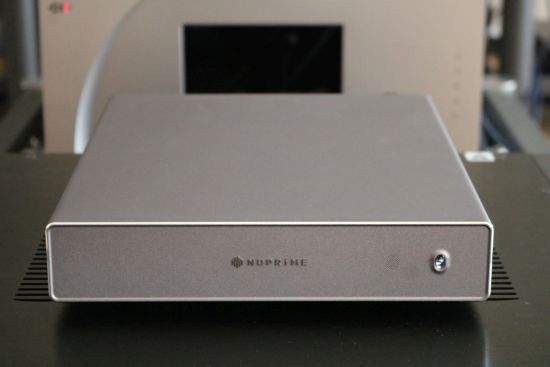
With a smart front panel but an otherwise simpler enclosure, NuPrime managed to keep the price of the AMG STA the same as for the ST-10, in spite of more complex electronics. The front panel is machined from a solid piece of aluminum with a protruding NuPrime Brand name. Unusually, the power LED is mounted underneath and behind the power switch, lighting it in a nice and understated fashion when viewed from the listening position.
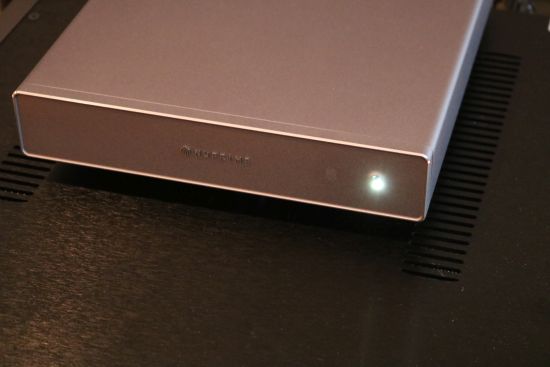
When standing up and looking at it from an angle, however, it is super-bright. Between this solution and the highly dimmed deep blue LED in the ST-10, I prefer the latter.
Jason Lim responds: “Thanks for your feedback. We will make an adjustment by adding a filter to the LED”.
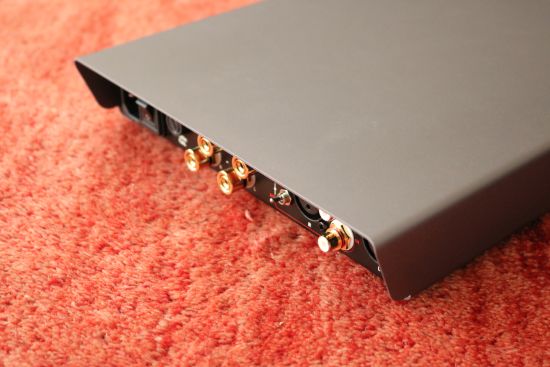
The speaker connectors are very tightly-spaced on the ST-10, and the same is the case on the AMG STA. There simply isn’t much real estate, to begin with. But due to the louver-like extension on the rear, spades can only be inserted from below, meaning that the AMG STA needs to be positioned at the edge of the shelf or component underneath it. Thankfully, NuPrime did clear enough space to allow the use of beefy high-grade IEC power connectors.
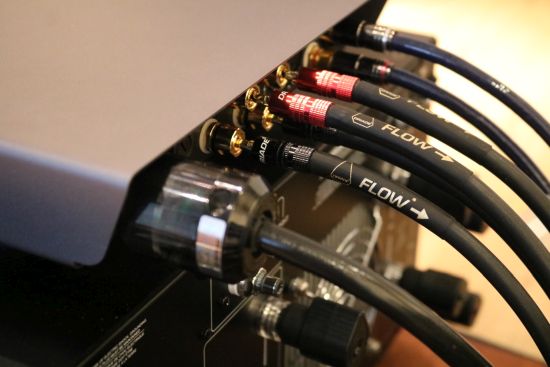
Bananas work just perfectly… but when using Spades, especially those with long metal parts such as with the Jorma cable, one has to be very careful not to make a short
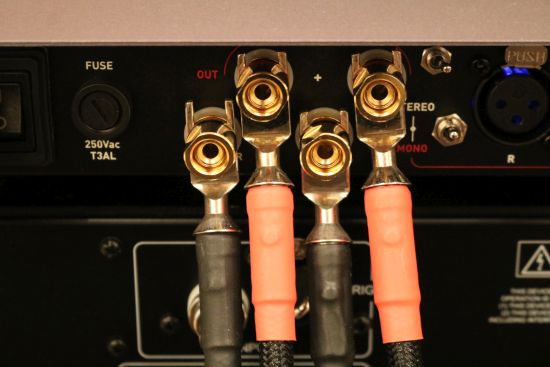
Connectivity matters and working principles aside, from the moment that I switched it on, I heard that the AMG STA is something special.
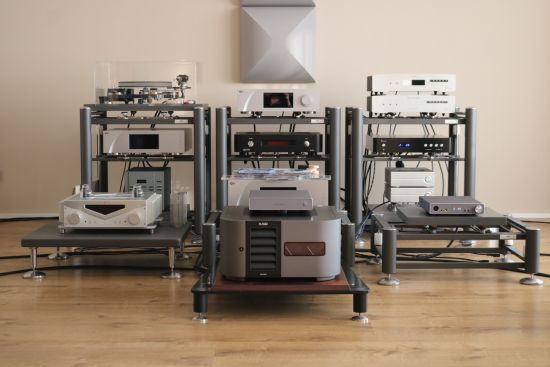
System Context
I will listen to the AMG STA, first using different setups in the same room, consisting of either the Aqua Formula xHD DAC with V2 output board and Audio-GD Master 1 combo, or the CH Precision C1 DAC. The source in both cases is the Antipodes CX running Roon via HQPlayer to the Aqua LinQ, connected via AQLink I2S cable to the Formula xHD and via a Jorma AES/EBU cable to the C1 DAC. The loudspeakers are the Magico S1 MkII’s and, in a later stage, the WvL SONs. I will also briefly involve the AMG HPA, an analog preamplifier and headphone amplifier.
Lastly, I will also listen to the AMG STA power amp in audio buddy Niels’ setup, which in its core is formed by the Aurender S10 music server, Mola Mola Tambaqui DAC and Spectral DMC-30SV preamp. Here, it will drive the Magico Q5 loudspeakers.
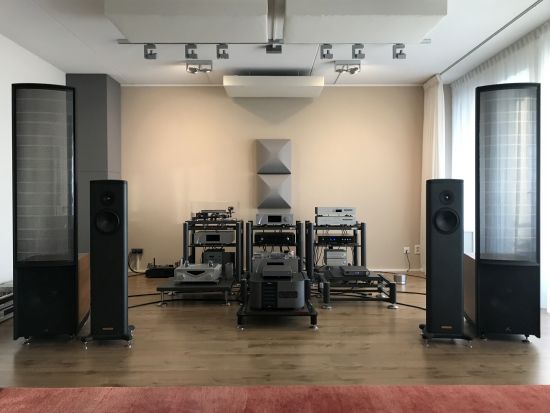
Listening – Magico S1 MkII
To start off, I listened to the ST-10, connected in-between the Audio-GD Master 1 preamp and Magico S1 MkII speakers. This produces a sound that I am intimately familiar with: very robust and impactful, even more so than the A1.5 in that respect, with lots of dynamic slam and a very realistic timbre. It’s an always enthusiastic reproduction that never fails to make the foot tap. The relative downsides compared to the best that I have available, the 31.000-euro CH A1.5 amplifier, are mainly resolution, treble refinement and fluidity. And while the humble ST-10 will not replace the A1.5 for these reasons, it certainly has a joyful way of music-making that works remarkably well even with the revealing Magicos.
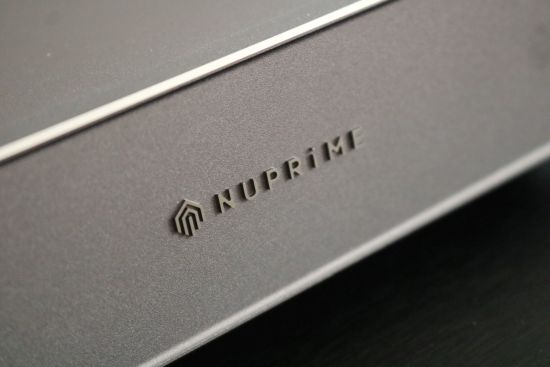
Changing from the ST-10 to the AMG STA was like changing to a completely different brand of amplifier. It does not have the ST-10’s sonorous ballsiness nor entirely all of its dynamic impact but otherwise, it seriously ups the game. I’m not kidding: the AMG STA raises the quality in these areas all the way into high-end territory. And that is absolutely no hyperbole!
How shall I put this… It’s a shame that I have no Jeff Rowland amplifiers anymore because I’d swear that the AMG STA’s sound is very close. And I don’t mean close to the early ICE-power Model 201’s or the later Pascal Model 525 but a mix of the Class-AB Model 10 and Model 6 monos. From memory (dangerously deceptive, I know) and deducting via a range of other components (making matters worse) but in the same room, I would swear that the AMG STA has the transparency, refinement and agility of the Model 6 and a portion of the warmth and smoothness of the Model 10, only really falling behind in terms of ultimate tonal fullness.
Of course, if you’ve never heard any JRDG amplifiers then all that means exactly zero. But if I add that the cost of these classics was around 15K and 11K in euros 20 years ago, then that should indicate just how class-defying the AMG STA’s performance actually is.
A better example would be the current JRDG Model 625 S2 Class-AB amplifier for 21.000 euros. Does the AMG STA beat it? Well, no. The Jeff has a tonally richer sound with more authority and a more fleshed-out sound but, otherwise, to be honest, I don’t feel that the AMG STA concedes anything in terms of refinement, agility, low-lever resolution, transparency and overall finesse.
CH Precision electronics have all the fluidity and refinement that I loved from JRDG components, along with more authority and increased precision and transparency, which is why I changed teams some time ago. So, how does the AMG STA compare to the 31K CH A1.5? Actually, it comes much closer than it has a right to! In terms of refinement, resolution and fluidity it is almost on par which I think is absolutely bonkers given how world-class the A1.5 is in these respects. Importantly, there is not a hint of artificiality to the AMG STA’s delivery and the word “digital” or “switching” certainly does not spring to mind. And as long as you don’t make direct comparisons or know any better, there’s remarkably little amiss. Where the Big Swiss ultimately does retaliate is in terms of bass-precision and -articulation, dynamic power, tonal fullness and overall authority. Fair enough.
As I mentioned, the AMG STA not only addresses all of the ST-10’s weaker areas but actually raises the overall quality to such an extent that it comfortably positions itself among high-end competitors that cost multiples upon multiples. Alas, in the process, it does give up a good portion of the ST-10’s bass heft and overall robustness. But otherwise, it sets the benchmark, not only in its price class but also far, far beyond.
Given that both amplifiers cost exactly the same, this means that the decision between the two will come down entirely to personal taste and system synergy. If you don’t need the very best in bass slam and outright ballsiness, go with the AMG STA. If rocking out is most important to you, go with the ST-10. In that respect, there is very nearly nothing that can beat it. Of all the amplifiers that I have heard so far, only the Anthem STR and the Classe Delta v3 can top it in terms of dynamic slam.
It’s also worth noting that even on the highest levels, I can confirm that it remains a bit of a horses-for-courses exercise, for instance, a CH amp doing certain things a Soulution can’t and vice versa.
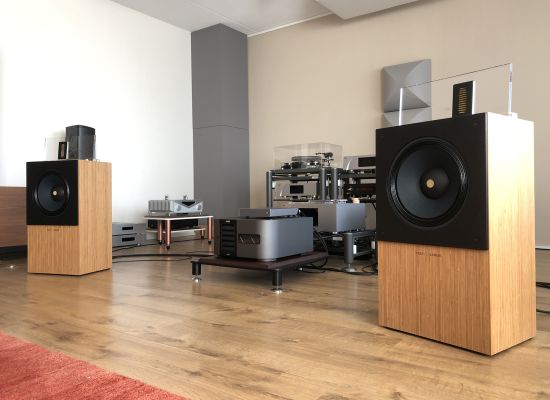
Listening – SONs
Over for another review are a very special pair of WvL SON loudspeakers that use a Field Coil woofer combined with an Air Motion Transformer tweeter to arrive at a super-expressive sound that is utterly revealing of everything that is connected upstream.
With these speakers, I used the NuPrime AMG STA amplifier both with the Aqua DAC and Audio GD preamplifier as well as with the C1 DAC directly.
I should note that I connected the AMG STA after having tried all other options and having completed the review process for the SON speakers. As such, I was fully aware of their capabilities, and therefore it was all the more surprising how immaculately the little amp performed even with the extremely revealing SONs. I did feel that the inherently smooth-sounding Driade Flow 405 speaker cable that I frequently use in this setup was not ideal for the AMG STA. This is because the NuPrime amp has precisely enough smoothness built-in to not require further romanticizing of the signal. The Jorma Trinity worked perfectly and I imagine that there will be plenty of other speakers cables that perform well, as long as they are fast-sounding, articulate and essentially neutral.
Indeed, unlike the ST-10, the AMG STA has so much finesse and is so retina-like in its resolution and fluidity that it will take a particularly bad cable to make it sound rough or dry. But that’s not to say that it smooths over details. When reading the manufacturer’s website, one could get the impression that the AMG STA sounds extra-harmonically-rich and maybe even colored. Having heard the amplifier with the SONS as well as my Magico S1 MkII’s and audio buddy Niels’ Magico Q5’s (as I will describe further below), I will agree that the amp is unusually fluid and refined not only for a Class-D design but even if it were a Class AB amplifier. But I never had the impression that the AMG STA is in any way colored. Rather, it is very pure and neutral and utterly linear, with just a hint of sweetness.
With the S1 MkII’s and after having heard the ST-10, I felt that the AMG STA’s bass could be more robust and impactful and the sound could do with a little more dynamic impact. Both the ST-10 and the CH amp performed more impressively in that respect. However, when combined with the inherently agile and expressive, full-bodied and dynamic SONs, I could just not find fault with the AMG STA’s presentation even in its relatively weaker areas. Sure, if you’d connect the other amplifiers then the SONs would perform even more impactfully but without direct comparison, there’s simply nothing amiss.
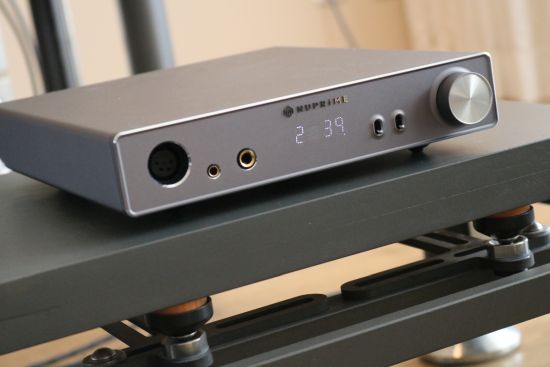
AMG HPA preamp
When delivering the AMG STA power amplifier, Dutch Distributor Dimex also had the 1.895-euro AMG HPA preamp and headphone amplifier available. While this review will focus primarily on the power amplifier, I agreed to also listen to the preamp as part of a sideline story.
Before going there, I should note that the AMG HPA is not the AMG STA’s natural partner. The AMG PRA is actually designed to bring up the best in AMG STA. Early next year, the plan is to write a follow-up to this review in which I will include the AMG PRA.
Just to make sure I was obtaining the maximum performance, the preamp has been allowed a copious amount of time (over 2 weeks) to run in and warm-up, prior to the start of my comparisons.
In terms of overall balance, the AMG HPA is something of an ideal companion for the AMG STA because of its remarkably robust bass and full and harmonically rich sound. These attributes perfectly complement the AMG STA’s relatively weaker areas. The preamp has good resolving abilities, great PRaT and absolutely no harshness. The end result of the two products is a very well-balanced sound that is perfectly representative of the combined products’ price class.
However, the AMG STA power amp is so finely resolved and so transparent that I also hear that the overall resolution and refinement drop a few notches when the AMG HPA is used instead of the Audio-GD Master 1 preamp or a signal direct from the C1 DAC. It just paints with broader strokes and while the sonic match is great, it ultimately limits the AMG STA’s audiophile performance.
To be fair: the C1 is stratospherically-priced and the Audio-GD and the Audio-GD is at an advantage with its 100% Chinese roots. At the AMG HPA’s retail price there are precious few American or European preamps that will perform better and certainly even fewer with such great ergonomics.
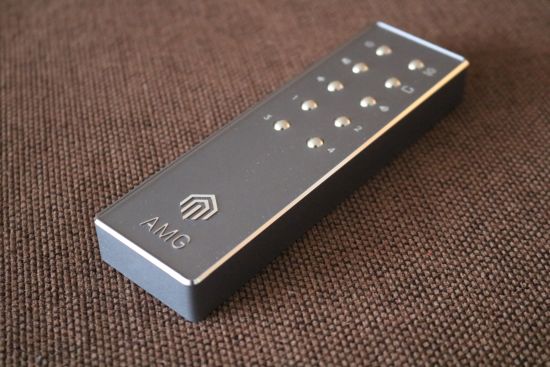
Machined from aluminum and with ball-bearings as knobs, this remote control sets the standard not only in the AMG HPA’s price class but far beyond!
I am very positive about the preamp’s looks and functionality. The volume knob works smoothly and precisely, its micro-pore led displays are highly legible and the supplied full-metal remote control puts the cheap plastic affairs of many competitors, even high-priced ones, to shame.
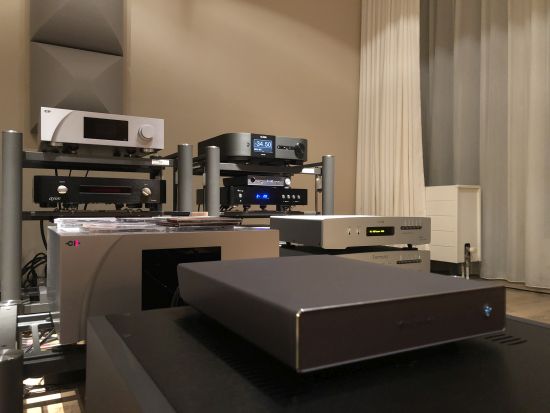
The AMG HPA is an excellent preamp in its own right but it does not quite reach the same audiophile heights as the AMG STA power amp. Of course, one of its attractive uses is as a headphone amplifier and for analog sources, an analog preamp is required but if your sources are digital-only, then I’d advise getting a DAC with a good (digital) volume control and prepare to be amazed at the AMG STA’s audiophile quality.
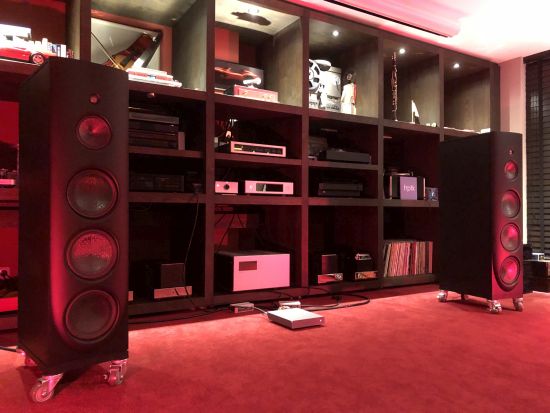
Listening – Magico Q5
After a 1,5-hour drive to Niels’ residence and without any warm-up, the AMG STA was connected to the Magico Q5’s after we had listened to them using the Jadis JA200 Gold tube power amplifiers. A pretty daunting comparison, right? But when starting the first track of the small playlist that we had prepared we were instantly impressed. No, the diminutive amp did not sound the same as the 4-chassis Jadis beast (that would be a miracle) but it most definitely sounded remarkably fluid and superbly hi-res. Especially in the midrange, we felt that the sound could do with a little bit more sweetness. Would that be the amp’s Class-D genes finally being exposed? As it turned out, not at all.
After having dinner we repeated the playlist only to look each other in the face after 20 seconds as we both felt that the sound was MUCH improved. The midrange had now attained just the right amount of sweetness and harmonic richness while retaining its incredible resolution and also the bass was now a little fuller and more powerful.
Apparently, even more so than the SONs, the Q5’s are ruthlessly revealing and this was the first time that I noticed the AMG STA sounds best after 30-60 minutes. Of course, the Q5’s are ultra-clean, to the point that many people find them to sound cold. Personally, I don’t feel that way (anymore), they’re just merciless but when all’s good, all is indeed FANTASTIC.
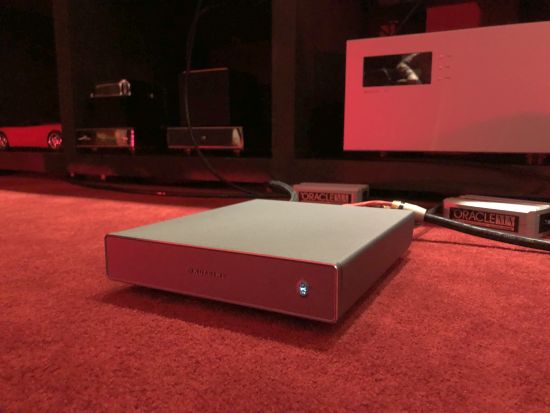
It can’t be seen in the photos but to avoid “floating” the amp on the thick carpet, I used cones underneath
And what about power? Well, we did not crank up the volume all the way to the levels that we would do when the Q5’s are driven by big solid-state amplifiers but, trust me, we pushed it far enough to know that the AMG STA has no problems whatsoever driving these difficult speakers. Dynamically, also, there was absolutely nothing amiss. In fact, we both felt that the Soulution 711 did not sound any more dynamic or expressive when we fired it up next.
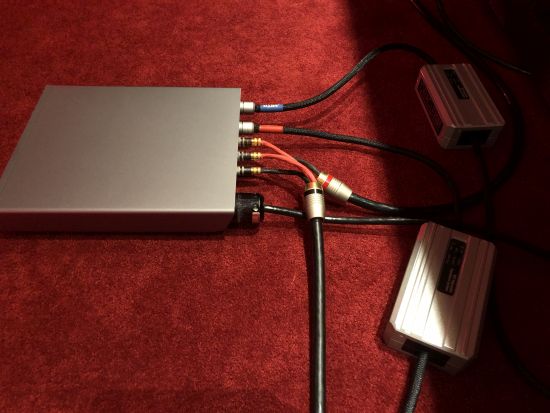
The relatively beefy Nirvana speaker cables are terminated with Bananas, making for an easy and fool-proof connection
So was the AMG STA then the better match? Well, all things considered, no. But that’s a matter of system synergy. In Niels’ room, the Q5’s sound a little lean in the 100Hz region and that’s one of the main reasons why the Soulution 711 does a better job. The AMG STA had excellent control in the bass. Actually, it had better articulation and pitch definition than the 711 but it was at times a little too lean and could do with more pressure. The 711 also sounds more sonorous and tonally fuller but I’m on the fence as to whether I prefer that to the cleaner and more neutral and more hi-res AMG STA’s presentation. What I do know is that while the bass was more enjoyable via the 711, it took some time for me to get used to the lower overall resolution and comparatively darker and slightly rough treble.
Conclusion
The AMG STA not only addresses all of the ST-10’s weaker areas but actually raises the overall quality to such an extent that it comfortably positions itself among high-end competitors that cost multiples upon multiples. Alas, in the process, it does give up a portion of the ST-10’s bass heft and overall robustness. But otherwise, it sets the benchmark, not only in its price class but also far, far beyond.
This means that the decision between AMG STA and ST-10 will come down to personal preferences and system synergy. But no matter how you look at it, what the AMD STA achieves is absolutely class-defying. Starting now, the ST-10 must share its position as my favorite affordable amplifier with the AMG STA.
Link to the review -->https://www.hifi-advice.com/blog/amplifier-reviews/power-amplifier-reviews/nuprime-agm-sta-stereo-power-amplifier/


